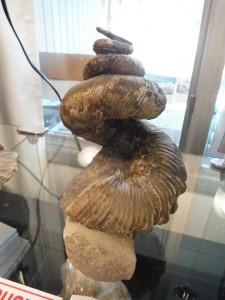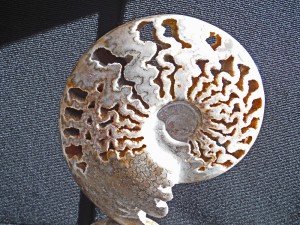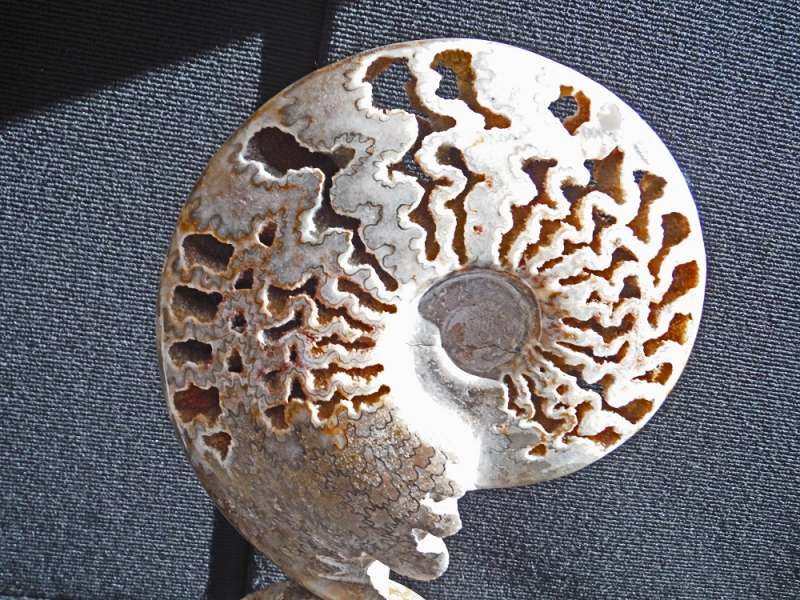
“Whoa – that’s a funky fossil”, I remember thinking the first time I saw this twisted, snake-like fossil. It looked like the creature had been frozen into stone while groping upward in an eerie, loose coil. This type of fossil looked very similar to the familiar, tightly coiled ammonite fossils, but with an odd twist – literally. Ammonite fossils are like the nautilus we can find swimming in the seas today (read about ammonites here). Their hard shells are usually firmly stuck together in a tight coil, but the ones I saw looked like unraveled ammonites. They are called hetromorph (meaning “different shape”) ammonites. Looking at ammonite fossils, there’s a diverse array of different types, sizes, colors, and shell patterns. Evolutionists often try to use these different types of ammonites to support evolution, but there are some issues with the evolution of ammonites.

As seen from the outside, iridescent shells of some ammonites can be quite eye-catching. The inside of their shells are a wonder that can be seen if you slice the fossil in half. There, you can see that the inside of the coiled shell is divided into a series of chambers, each getting smaller as they wind toward the tightest part of the coil. In biology, ammonites are classified as cephalopods, like a squid or cuttlefish, and use the chambers of their shells to help them move as needed through the water.
The little walls of these chambers are called septa and the points where they join to the main part of the shell are sutures. Different patterns of these sutures, some straight, and others in intricate, wavy lines, are used to distinguish types of ammonites. Researchers think the ammonites with less-intricate sutures may have lived in deeper waters than the

ones with more complex suture patters. Rather than evolution, the difference is probably best explained by the different environments in which each type of creature lived or died. It’s interesting to notice that ammonites with more simple sutures are found beginning at the Cambrian rock layers (among the lowest and oldest rock layers) and are found in modern ammonites today. That would be 500 million years of experimenting for this creature, just to decide sticking to the original design works best. Simply a diverse array of the same created kind makes more sense of the fossil record.

Different types of ammonites are often used to categorize rock formations into the classic geologic timescale (more on the geologic timescale/column here). Evolutionists look at these ammonite fossils and interpret them as different types of a creature thriving and going extinct over vast periods of time. Young earth geologists look at those same fossils and instead see a creative array of the same kind of creature, all living at basically the same time, but in different environments. Animals can’t change into just whatever they want, but they do have an amazing amount of pre-programmed flexibility in their genes to adapt to different environments. You can’t change into just anything you want, but, through the grace of God, all the tools you need are available to help you adapt to the challenges and pressures you will face in your life. Just don’t let it get you all unraveled, like the quirky hetromorph ammonite!
Copyright Sara J. Bruegel, April 2016
References:
- Frank Sherwin, M.A. 2004. Ammonite Evolution?. Acts & Facts. 33 (12). Institute for Creation Research. Last accessed 4/8/16. http://www.icr.org/article/ammonite-evolution
- Gordon Howard. Index fossils—really? Creation Magazine 34(4):52–55. October 2012. Creation Ministries International. Last accessed 4/8/16. http://creation.com/index-fossils
- Jann Vendetti.The Cephalopoda: Squids, octopuses, nautilus, and ammonites. 2006. University of California Museum of Paleontology. Last accessed 4/8/16. http://www.ucmp.berkeley.edu/taxa/inverts/mollusca/cephalopoda.php
- Harold Levin. 2010. The Earth Through Time, 9th edition. Pages 352-353. John Wiley & Sons Inc. United States.
- Heather Brinson Bruce. Masters of Disguise. 2016. Answers Magazine 11(2). Pages 66-72. Answers in Genesis.






